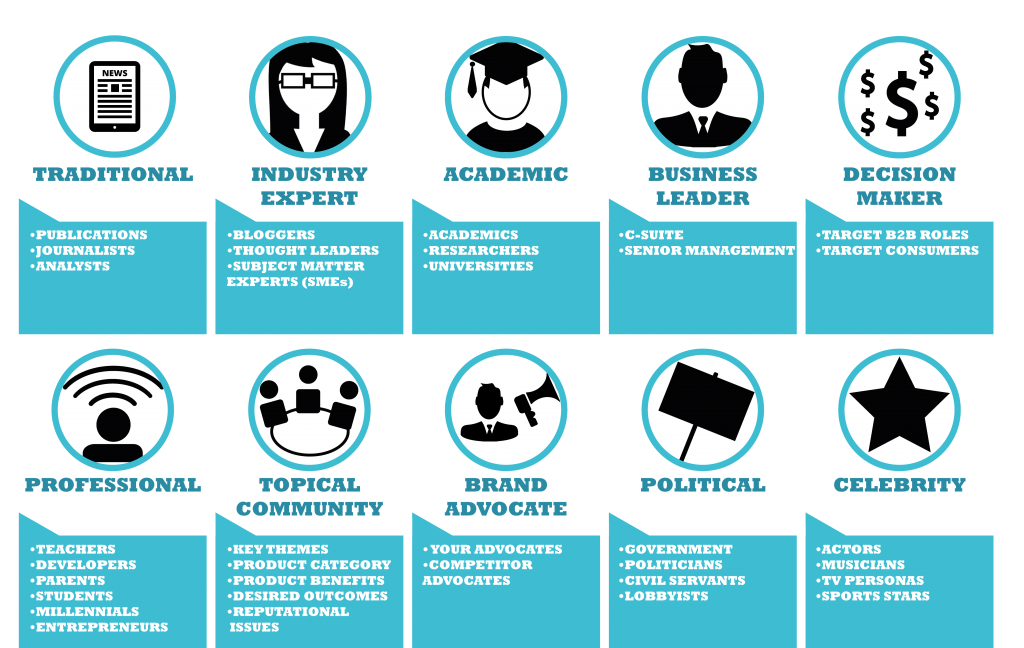Last week, we covered how you can outline your influencer marketing strategy. This week we take you through how you can identify your influencers, as per our Definitive Practical Guide to Influencer Relationship Management.
Personally, I can’t think of anything more crucial to successful influencer marketing than identifying the right influencers to target. Getting this right can truly mean the difference between a substantial amount of wasted resource and even potentially brand damaging marketing and living the influencer marketing dream.
In this instalment we take a concise and practical look at the fascinating question:
“How do I identify my target influencers?”
In-flu-who?
To answer this question you first have to define exactly what is meant by the term ‘influencer’– both generally and specifically to your brand.
To put it simply; an influencer can be in theory anyone – whether they’re internal employees, external individuals, brands, publications or stakeholders. But what every influencer has in common, is that their opinion and expertise carry weight and influence in the industry, with brands’ and competitors’ fate often falling into their hands.
With such a large pool to choose from, how do you whittle down those that are worth your resource, time and energy in pursuing as influencers for your business? Getting this right can certainly mean the difference between successful and potentially harmful influencer marketing.
Who are your audience influenced by?
The audience forms one of the three corner stones of a successful influencer marketing strategy – brand, audience and the influencer.
Why are influencers so important? Because they have such a great impact on our consumers’ decisions. So with this said, the audience must be at the heart of this identification piece. So, before we can really answer ‘which influencer’ we must answer ‘what audience’.
It is likely that you already have some grip on the target audience for your business, whether that be a consumer or business audience. Yet it is of paramount importance at this stage of influencer marketing to go back and strongly define exactly who you are hoping to target.
A useful way to break down your target audience in influencer marketing is to highlight both which demographics (categorical attributes) and which psychographics (behavioural attributes) they fall in to. Knowing this will allow you to judge the perceived value of an influencer based on their given influence over that particular audience.
Identifying your influencers- Tech or talent?
When presented with the question of identifying your target audiences, you will likely hear a number of differing opinions on whether to use some sort of technology or human intelligence to find and pick the right influencer. Undoubtedly the best way to approach influencer marketing is to actually use both options. Technology can drastically lower your search time, however a level of human intelligence and judgement should always be used when dealing with other humans.

“Let’s say you’ve parsed your keywords and entered them into an influencer identification solution. You get back a list of potential matches but now, a little something I call human intelligence comes into play. This means put your detective hat on and start searching each influencer’s social footprint to see if they are truly influential or just a retweeting machine. And if they can really help you achieve your KPIs.”
Angela Lipscomb, Influencer Relations Manager, SAS
Once you have used this combined method to identify your influencers, much like all marketing, it is very important to segment these into specific personas in order to approach and deal with them in the most effective way.
Using this mixed approach will allow you to find influencers that hold a highly relevant audience as well as those that match closely with your brand in terms of tone of voice, values and representation. Yet, to define the influencers you wish to target even further you also need to establish the type of personas that your influencers can fit into – there are a number to choose from, with each having individual benefits and levels of influence over their audience.
Influencer Persona types

Not only should the influencer’s persona be considered, but also their position in the market. The full whitepaper gives a much higher level of detail and insight into these areas, but to give a high-level overview of each type:
Everyday Influencers – 1-1000 followers
Small, every day consumers of your own or similar products. These types of influencers will often not consider themselves highly influential and will rarely monetise their audience. While their audience may be small, their influence is still significant – think customer reviews on Amazon.
Brand Advocates – 1 to ∞ followers
This type of influencer can be at any level, from everyday influencers right through to macro or celebrity. However, what separates them from others is the fact that they are earnt advocates of your brand, product or service. Often these types of influencer are hard earnt through your brand’s actions, yet can create the most powerful content that advocates your brand.
Micro-Influencers – 1,000 to 20,000 followers
Micro-influencers hold a smaller reach than other larger influencers in their niche. The major benefit to these influencers is that they usually hold very high levels of engagement, relevancy and trust amongst their following.
Professional Influencers – 20,000 to 100,000 followers
This type of influencer is the jump between micro and macro and is where an influencer really starts to take their influence seriously in terms of leveraging their audience and providing high levels of benefit. This type of influencer is often looked upon as an industry expert and highly respected.
Macro Influencers – 100,000 to 300,000 followers
This type of influencer is often large enough in terms of expertise and reach to warrant some sort of representation with a talent manager. They are often in a similar space in terms of their reach as celebrity influencers.
Celebrity Influencers – 300,000+ followers
This type of influencer usually has a very large following and will be represented by a manager or talent agency. Known to collaborate with brands on a paid basis.

” Creating an actionable segmentation of influencers and how best to engage them is a critical part of influencer marketing that is often missed. “
Dave Chaffey, CEO, Smart Insights
Key measures of influence
What it comes to measuring influence in influencer marketing, there are four key measures that you should analyze to find the key influencers in your market: reach, relevance, resonance and reference.
- High Relevance is important because these individuals are likely to have more expertise in their topic. Are they relevant to your brand? Are they genuinely knowledgeable and passionate in this area? The Zoellas of this world may well be popular but are they actually relevant to your B2B topic? Are yours and their audience similar?
- High Reference is likely to highlight thought leaders, consultants or conference speakers that are respected and seen as being authoritative by their peers.
- High Resonance signifies that an influencer’s content gains traction and drives engagement. Chances are, an influencer scoring highly in this area are engaging with their followers. Angela Lipscomb highlights the idea in her LinkedIn post that utlimately, every brand’s end goal is to evoke action- whether that’s downloaded content, visiting a webpage or considering your software. These actions are far more likely to occur when an influencer engages with their audience.
- High Reach gives you an indication of the size of their audience and their popularity. We advise that you do not prioritise reach too much, as some may be buying followers and automating their accounts. Angela Lipscomb also mentions in her post that she looks for influencers publishing and sharing original, relevant content. She also looks out for and avoids influencers that are prolific retweeters of other influencers’ content.

“Don’t confuse influence with popularity. People are choosing sexiness of virality over relevance. Content needs to be exclusive.”
Jason Miller, Global Content Marketing Leader, LinkedIn
 “As an industry we have to be careful not to mistake people who RT content on a number of topics for influencers as some of them are gaming the system and treating social like a video game.”
“As an industry we have to be careful not to mistake people who RT content on a number of topics for influencers as some of them are gaming the system and treating social like a video game.”
Jim Marous, FinTech Influencer & Retail Banking Publisher
Define your topical focus
In order to identify and rank your influencers according to the 4Rs, it is important that you define a topical context around one of the following areas:
- Thought leadership themes (e.g. digital transformation, artificial intelligence)
- Key verticals (e.g. manufacturing, education)
- Product categories (e.g. mobile phones, makeup, driverless cars)
- Your brand vs. competitors (e.g. Microsoft vs. Apple, Google)
- Your products vs. competitor products
- Industry Issues (e.g. climate change, data security, obesity)
Breaking down your business areas into topical contexts that resonate with influencers will be a key exercise for identifying your relevant influencers. Influencers are far more likely to talk about innovation, product categories, industry issues and less likely to talk about brands. Examples per sector are:

There’s tonnes more information on this subject in the full white paper: The Definitive Practical Guide to Influencer Relationship Management. As always, I would love to hear your thoughts and opinions on the subject and also answer any questions you might have. Please feel free to direct email me on Owain@ojawilliams.com or visit my blog www.ojawilliams.com.
To download the full white paper, click the button below.

DOWNLOAD NOW!
TAGS
DEFINITIVE PRACTICAL GUIDE TO INFLUENCER RELATIONSHIP MANAGEMENT
Download this free white paper including guidance and frameworks, that takes you through the whole influencer marketing process, in a practical and actionable way.

